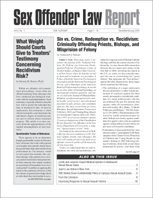DNA Identification in the Criminal Justice System Part I: Science, Development, and Methods of Employing DNA Testing
Author: Jeremy Gans.; Gregor Urbas.
Source: Volume 04, Number 02, February/March 2003 , pp.17-20(4)

< previous article |next article > |return to table of contents
Abstract:
Editor’s Note: DNA profiling and the forensic use of DNA evidence have undergone considerable development since the Australian Institute of Criminology first examined this topic in 1990 in Trends and Issues no. 26. However, many of the issues raised in relation to scientific reliability, standardization of profiling techniques, laboratory accreditation and quality control, improved population and data analysis, and privacy are still the subject of disputation in legal proceedings. This first paper in a series [to appear in upcoming issues of SLR] examines the science of DNA identification and its use during criminal investigations and in criminal proceedings, including criminal trials, appeals and post-conviction proceedings. It describes the main benefits and costs of the increasing role of DNA identification in the criminal justice system.Keywords:
Affiliations:
1: University of Melbourne Law School; 2: Australian Institute of Criminology.